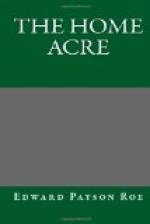unchecked; and this propensity must be severely curbed
to render a bed productive. Keeping earliness
and high flavor in view, I would next recommend the
Black Defiance. It is not remarkably productive
on many soils, but the fruit is so delicious that
it well deserves a place. The Duchess and Bidwell
follow in the order of ripening. On my grounds
they have always made enormous plants, and yielded
an abundance of good-flavored berries. The Downing
is early to medium in the season of ripening, and
should be in every collection. The Indiana is
said to resemble this kind, and to be an improvement
upon it. Miner’s Prolific is another kindred
berry, and a most excellent one. Among the latest
berries I recommend the Sharpless Champion, or Windsor
Chief, and Parry. If one wishes to raise a very
large, late, showy berry, let him try the Longfellow.
The Cornelia is said to grow very large and ripen
late, but I have not yet fruited it. As I said
fifteen or twenty years ago, if I were restricted to
but one variety, I should choose the Triomphe de Gand,
a foreign kind, but well adapted to rich, heavy soils.
The berries begin to ripen early, and last very late.
The Memphis Late has always been the last to mature
on my grounds, and, like the Crystal City, is either
a wild variety, or else but slightly removed.
The Wilson is the great berry of commerce. It
is not ripe when it is red, and therefore is rarely
eaten in perfection. Let it get almost black
in its ripeness, and it is one of the richest berries
in existence. With a liberal allowance of sugar
and cream, it makes a dish much too good for an average
king. It is also the best variety for preserving.
It should be remembered that all strawberries, unlike
pears, should be allowed to mature fully before being
picked. Many a variety is condemned because the
fruit is eaten prematurely. There is no richer
berry in existence than the Windsor Chief, yet the
fruit, when merely red, is decidedly disagreeable.
The reader can now make a selection of kinds which
should give him six weeks of strawberries. At
the same time he must be warned that plants growing
in a hard, dry, poor soil, and in matted beds, yield
their fruit almost together, no matter how many varieties
may have been set out. Under such conditions the
strawberry season is brief indeed.
While I was writing this paper the chief enemy of
the strawberry came blundering and bumping about my
lamp—the May beetle. The larva of
this insect, the well-known white grub, has an insatiable
appetite for strawberry roots, and in some localities
and seasons is very destructive. One year I lost
at least one hundred thousand plants by this pest.
This beetle does not often lay its egg in well-cultivated
ground, and we may reasonably hope to escape its ravages
in a garden. If, when preparing for a bed, many
white grubs are found in the soil, I should certainly
advise that another locality be chosen. The only
remedy is to dig out the larvae and kill them.
If you find a plant wilting without apparent cause,
you may be sure that a grub is feeding on the roots.
The strawberry plant is comparatively free from insect
enemies and disease, and rarely disappoints any one
who gives it a tithe of the attention it deserves.




